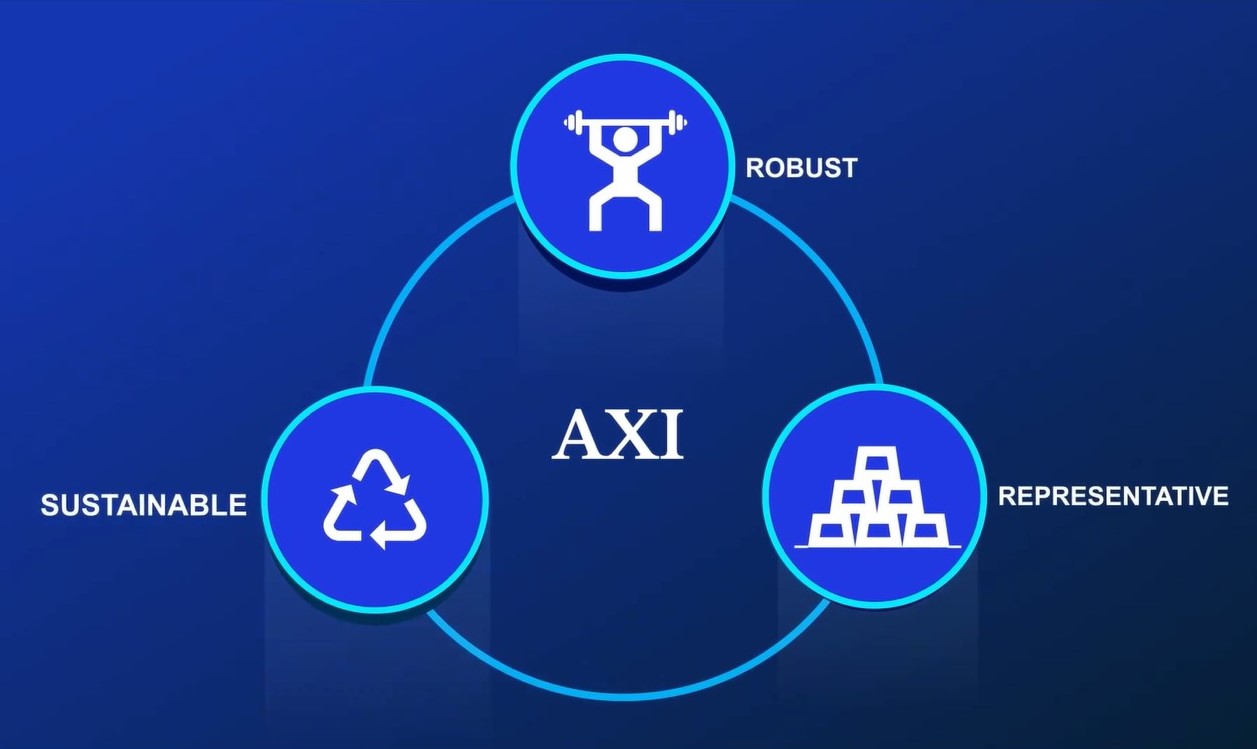
About AXI
AXI is a weighted average of the credit spreads of unsecured US bank funding transactions with maturities ranging from overnight to five years, with weights that reflect both transactions volumes and issuances
AXI can be added to Term SOFR (or other SOFR variants) to form a credit-sensitive interest rate benchmark for loans, derivatives, or other products
To explore licensing options for AXI, please contact Invesco Indexing's client engagement team.
How It Works

Robust
AXI captures bank funding across the yield curve
AXI is computed from a sufficiently large pool of market transactions so that it can underly actively traded derivatives instruments used by banks and their borrowing customers to hedge their floating-rate exposures, without significant risk of statistical corruption or manipulation. Expert judgement is not used nor are executable quotes. Adopting an across-the-curve methodology ensures that the maximum number of transactions are captured within the index. AXI is not limited to the short-term unsecured markets that once underpinned LIBOR.

Representative
AXI always reflects banks’ true costs of funds
Since the 2008 Financial Crisis, banks no longer fund themselves at LIBOR and have shifted their funding further out the yield curve. AXI is highly correlated with banks funding costs because it captures this deeper pool of funding transactions. The index is a weighted average of credit spreads for unsecured debt instruments with maturities ranging from overnight to multiple years, with weights that reflect both transactions volumes and issuance volumes. The input data for AXI is obtained only from publicly available sources regulated by the U.S. Securities and Exchange Commission (SEC).

Sustainable
AXI automatically adapts to changes in bank funding composition
AXI reference rates were designed to maintain their hedge effectiveness and robustness over time and can be reliably computed in all economic conditions, including in times of market stress. The indices automatically adapt to future changes in bank funding composition ensuring the representativeness and robustness of the indices are sustained through time. AXI works in conjunction with the Secured Overnight Financing Rate (SOFR) which was identified by the Alternative Reference Rates Committee (ARRC) and is therefore suitable for usage in a wide variety of products.
Latest AXI Rates
The following table reflects recent values of USD AXI and its available tenors. Please note that the highlighted tenors are the most generic tenors calculated.
| Term AXI (%) | Average AXI (%) | ||||||||
|---|---|---|---|---|---|---|---|---|---|
| Overnight** | 1M** | 3M** | 6M** | 12M** | Unscaled AXI (%) | 30D | 90D | 180D | |
| REFINITIV | .IIAXION | .AXIION | .IIAXI3M | .IIAXI6M | .IIAXI1Y | .IIAXI | .IIAXI30A | .IIAXI90A | .IIAXI180A |
| BLOOMBERG | AXIION | AXIIT1M | AXIIT3M | AXIIT6M | AXIIT12M | AXIIUNS | AXIIA1M | AXIIA3M | AXIIA6M |
| 18-Jul-2025 | -0.01539 | -0.31558 | -0.48953 | -0.46992 | -0.11710 | 0.33205 | -0.01644 | 0.47836 | 0.62646 |
| 17-Jul-2025 | -0.01533 | -0.31431 | -0.48758 | -0.46828 | -0.11710 | 0.34111 | -0.01650 | 0.47733 | 0.62701 |
| 16-Jul-2025 | -0.01583 | -0.32451 | -0.50343 | -0.48374 | -0.12143 | 0.34671 | -0.01660 | 0.47623 | 0.62757 |
| 15-Jul-2025 | -0.01590 | -0.32607 | -0.50616 | -0.48812 | -0.12612 | 0.35692 | -0.01670 | 0.47492 | 0.62812 |
| 14-Jul-2025 | -0.01608 | -0.32967 | -0.51464 | -0.50104 | -0.13983 | 0.36439 | -0.01698 | 0.46247 | 0.62983 |
The following table reflects recent values of USD AXI in combination with the New York Federal Reserve's SOFR rates (known as SOFRx), and their available tenors.
| SOFR* | Average SOFR* | SOFRx | Average SOFRx | |||||
|---|---|---|---|---|---|---|---|---|
| Overnight | 30D | 90D | 180D | Overnight | 30D | 90D | 180D | |
| REFINITIV | USDSOFR= | SOFR1MAVG= | SOFR3MAVG= | SOFR6MAVG= | .IISOFRXON | .IISOFRX30A | .IISOFRX90A | .IISOFRX180A |
| BLOOMBERG | SOFRRATE | SOFR30A | SOFR90A | SOFR180A | SFRXON | SFRX30A | SFRX90A | SFRX180A |
| 18-Jul-2025 | - | 4.34899 | 4.34155 | 4.37561 | - | 4.33255 | 4.81991 | 5.00207 |
| 17-Jul-2025 | 4.34 | 4.34798 | 4.34131 | 4.37532 | 4.32467 | 4.33148 | 4.81864 | 5.00233 |
| 16-Jul-2025 | 4.34 | 4.34732 | 4.34107 | 4.37502 | 4.32417 | 4.33072 | 4.81730 | 5.00259 |
| 15-Jul-2025 | 4.37 | 4.34431 | 4.34040 | 4.37457 | 4.35410 | 4.32761 | 4.81532 | 5.00269 |
| 14-Jul-2025 | 4.33 | 4.34262 | 4.34073 | 4.37429 | 4.31392 | 4.32564 | 4.80320 | 5.00412 |
Latest FXI Rates
The Invesco / SOFR Academy USD Financial Conditions Credit Spread Index (FXI) follows the same methodology as AXI but the underlying transactions are expanded beyond banks to include all financial institutions as well as corporate funding transactions.
The following table reflects recent values of USD FXI and its available tenors. Please note that the highlighted tenors are the most generic tenors calculated.
| Term FXI (%) | Average FXI (%) | ||||||||
|---|---|---|---|---|---|---|---|---|---|
| Overnight** | 1M** | 3M** | 6M** | 12M** | Unscaled FXI (%) | 30D | 90D | 180D | |
| REFINITIV | .IIFXION | .IIFXI1M | .IIFXI3M | .IIFXI6M | .IIFXI1Y | .IIFXI | .IIFXI30A | .IIFXI90A | .IIFXI180A |
| BLOOMBERG | FXIXON | FXIXT1M | FXIXT3M | FXIXT6M | FXIXT12M | FXIXUNS | FXIXA1M | FXIXA3M | FXIXA6M |
| 18-Jul-2025 | -0.01181 | -0.24208 | -0.37550 | -0.36046 | -0.08982 | 0.53811 | -0.01289 | -0.01851 | 3.45629 |
| 17-Jul-2025 | -0.01189 | -0.24376 | -0.37813 | -0.36316 | -0.09081 | 0.54165 | -0.01294 | -0.01871 | 3.46256 |
| 16-Jul-2025 | -0.01189 | -0.24388 | -0.37834 | -0.36354 | -0.09126 | 0.54391 | -0.01301 | -0.01892 | 3.46924 |
| 15-Jul-2025 | -0.01211 | -0.24824 | -0.38535 | -0.37161 | -0.09602 | 0.54926 | -0.01307 | -0.01912 | 3.47592 |
| 14-Jul-2025 | -0.01245 | -0.25528 | -0.39852 | -0.38799 | -0.10828 | 0.55207 | -0.01323 | -0.01974 | 3.49536 |
The following table reflects recent values of USD FXI in combination with the New York Federal Reserve's SOFR rates (known as SOFRy), and their available tenors.
| SOFR* | Average SOFR* | SOFRy | Average SOFRy | |||||
|---|---|---|---|---|---|---|---|---|
| Overnight | 30D | 90D | 180D | Overnight | 30D | 90D | 180D | |
| REFINITIV | USDSOFR= | SOFR1MAVG= | SOFR3MAVG= | SOFR6MAVG= | .IISOFRYON | .IISOFRY30A | .IISOFRY90A | .IISOFRY180A |
| BLOOMBERG | SOFRRATE | SOFR30A | SOFR90A | SOFR180A | SFRYON | SFRY30A | SFRY90A | SFRY180A |
| 18-Jul-2025 | - | 4.34899 | 4.34155 | 4.37561 | - | 4.33610 | 4.32304 | 7.83190 |
| 17-Jul-2025 | 4.34 | 4.34798 | 4.34131 | 4.37532 | 4.32811 | 4.33504 | 4.32260 | 7.83788 |
| 16-Jul-2025 | 4.34 | 4.34732 | 4.34107 | 4.37502 | 4.32811 | 4.33431 | 4.32215 | 7.84426 |
| 15-Jul-2025 | 4.37 | 4.34431 | 4.34040 | 4.37457 | 4.35789 | 4.33124 | 4.32128 | 7.85049 |
| 14-Jul-2025 | 4.33 | 4.34262 | 4.34073 | 4.37429 | 4.31755 | 4.32939 | 4.32099 | 7.86965 |
Please note: the Invesco / SOFR Academy AXI and FXI reference rate family of benchmarks are published on a today ‘T’ basis with the exception of Overnight SOFRx and Overnight SOFRy which are published on a T+1 basis.
*The SOFR and SOFR AVERAGES data is sourced from newyorkfed.org and is subject to the Terms of Use posted at newyorkfed.org. The New York Fed is not responsible for publication of the SOFR and SOFR AVERAGES data by Invesco Indexing, does not sanction or endorse any particular republication, and has no liability for use.
(**) Invesco Indexing is aware of and assessing the term settings calculation methodology and the current market conditions, which have caused the calculated AXI and FXI money market tenors to generate data outside of normal ranges since the end of January 2025, some of which is potentially unreliable. Upon completion of the review, Invesco Indexing may provide further guidance regarding any proposed changes to the calculation methodology of the applicable standard tenors. The core, unscaled benchmark indices—AXI (Bloomberg ticker: AXIIUNS Index) and FXI (Bloomberg ticker: FXIXUNS Index)—used in institutional derivatives markets remain unaffected and continue to be published without interruption.
USD-AXI and USD-FXI enhanced transparency metrics table
The following table reflects key underlying metrics of USD-AXI and USD-FXI
| Benchmark | USD-AXI | USD-FXI | |
| Reference date | 18-July-2025 | 18-July-2025 | |
| Unscaled rate average maturity (years) | 1.71000 | 2.78753 | |
| Short term component | Transaction volume (USD millions) | 401,071 | 1,779,723 |
| Maturity (years) | 0.07345 | 0.04588 | |
| Number of transactions | 11,956 | 81,742 | |
| Long term component |
Capped transaction volume (USD millions)*
|
6,735 | 93,800 |
|
Uncapped transaction volume multiplier**
|
1.24824 | 1.26197 | |
| Maturity (years) | 3.56063 | 3.49523 | |
| Number of transactions | 39,650 | 605,772 | |
To explore licensing options for AXI, please contact Invesco Indexing's client engagement team.
Footnotes:
(*) The Financial Industry Regulatory Authority's (FINRA) Trade Reporting and Compliance Engine (TRACE) established dissemination protocols that included certain caps. The size disseminated is the total par value of the trade, subject to the limits of the applicable dissemination cap. For investment grade TRACE-eligible securities and agency debt securities, the current dissemination cap is $5 million. For non-investment grade TRACE-eligible securities, the current dissemination cap is $1 million. The uncapped transaction sizes are reported in the Enhanced TRACE dataset which is released to the public with several months of delay.
(**) The uncapped transaction volume multiplier (UTVM) can be multiplied with the Long term component capped transaction data to approximate the actual traded volumes for the long term component. The UTVM is calculated by comparing the most recent quarter of uncapped data available to the equivalent capped data.
Frequently Asked Questions
-
1. What is the Across the Curve Credit Spread Index (AXI)?
The Across-the-Curve Credit Spread Index (AXI)TM is a weighted average of the credit spreads of unsecured bank funding transactions with maturities ranging from overnight to five years, with weights that reflect both transactions volumes and issuance volumes. AXI can be added to Term SOFR (or other SOFR variants) to form a credit-sensitive interest rate benchmark for loans, derivatives and other products. Key features of AXI are summarized in our user-friendly infographic.
The Financial Conditions Credit Spread Index (FXI)TM is an extension of AXI that incorporates data based on transactions of both financial and non-financial corporate debt instruments and is approximately 500% more robust (Berndt, Duffie, Zhu, 2020).
-
2. What is SOFRx?
In addition, ‘all-in’ benchmark rates are being calculated and published where across-the-curve credit spreads are combined with variations of SOFR that are published and administered by the NY Fed. A benchmark comprised of a variation of SOFR plus AXI is referred to as ‘SOFRx’. A benchmark comprised of a variation of SOFR plus FXI is referred to as ‘SOFRy’.
-
3. Will AXI comply with the key principles announced by the Alternative Reference Rates Committee?
To the extent practicable, AXI will seek alignment with the key principles set out by the Alternative Reference Rates Committee (ARRC).
-
4. Is AXI intended to correlate highly with LIBOR?
No. AXI was not developed to emulate LIBOR. Criteria taken into account when developing AXI included:
“Hedging effectiveness: Highly correlated with U.S. bank cost of funds, as determined by recent market credit spreads for wholesale unsecured issues of U.S. banks and bank holding companies.
Robustness: Computed from a large enough pool of market transactions that the index can underlie actively traded derivatives instruments used by banks and their borrowing customers to hedge their floating-rate exposures, without significant risk of statistical corruption or manipulation.
Adaptable to changes in issuance patterns: The index should, within reason, maintain the first two properties even as banks change the maturity and instrument composition of their issuances in response to changes in regulation and market conditions.” (Berndt, Duffie, Zhu, 2020)
-
5. How will AXI adapt to potential future changes in the way banks fund themselves?
A future change in bank regulation or evolving market trends may result in banks adjusting their debt maturity structure. AXI was designed to automatically adapt to these changes.
When bank funding turns out to be short term, AXI gives greater weight to short-term spreads. When bank funding turns out to be longer term, AXI weighs to the long term.
Since there are almost no transactions with which to fix LIBOR, a representative credit spread would have to stay away from LIBOR and instead focus on the actual funding banks are getting.
-
6. How can market participants be confident that AXI will maintain its representativeness and robustness in the decades ahead given potential changes in market structure and regulation?
AXI is a dynamic credit spread that moves to where the actual bank funding transactions occur. For example, if banks began funding themselves at the 4-year point of the yield curve, AXI would weight transactions at that tenor.
AXI is fundamentally different to the other credit sensitive proposals in a few important ways: (1) it takes into account funding transactions that occur out to multiple years so it’s not limited to the short-term markets that once underpinned LIBOR, (2) it is a credit spread add-on to SOFR, not a standalone rate and therefore promotes the adoption of SOFR (3) AXI automatically adapts to changes in bank funding composition, so its representativeness and robustness are sustained over time.
-
7. Who created AXI?
SOFR Academy is grateful to the team of leading academics that authored the academic paper in which the Across-the-Curve Credit Spread Index (AXI)TM and the Financial Conditions Credit Spread Index (FXI)TM were conceived. Antje Berndt is a Professor of Finance at the College of Business and Economics, Australian National University. Darrell Duffie is the Adams Distinguished Professor of Management and a Professor of Finance at the Graduate School of Business, Stanford University, as well as a research fellow of the National Bureau of Economic Research. Yichao Zhu is a Senior Lecturer in finance at the College of Business and Economics, Australian National University. Professor Duffie chaired a Market Participants Group on Reforming Interest Rate Benchmarks (or the Market Participants Group on Reference Rate Reform). The group was established by the Financial Stability Board (Market Participants Group (2014)).
-
8. What were the Credit Sensitivity Group Workshops?
AXI was discussed at the Credit Sensitivity Group Workshops hosted by the Federal Reserve Bank of New York. Four workshops were held between June and August 2020 and aimed to build a shared understanding of the challenges that banks of all sizes and their borrowers may face in transitioning loan products away from LIBOR. They also explored methodologies to develop a robust lending framework that considers a credit sensitive rate/spread that could be added to SOFR.
-
9. Does the availability of a credit spread index reduce market reliance on SOFR, and thus lessen the “momentum” behind transition to SOFR?
No. “Whenever a loan is indexed to an AXI, it would also reference SOFR. So, use of a credit spread index does not imply less frequent reference to SOFR. The construction of floating-rate loan terms implies that the credit spread index would be used in different ways for different applications, including loans with different coupon periodicity and derivatives of different types.” (Berndt, Duffie, Zhu, 2020)
-
10. Why should the use of a credit spread index be sufficiently robust to support a large derivatives market?
“With the emergence of an active loan market based on a credit spread index, there would be many potentially important useful applications for hedging and speculation based on that index, some of which we have outlined here. It would tempt fate to choose a credit spread index that is not based on a large pool of transactions. Regulators and market participants can avoid painting themselves into that corner.” (Berndt, Duffie, Zhu, 2020)
-
11. AXI includes transactions over the previous month, therefore lagging the most recent available prices. Does this not imply a staleness concern?
“Reliance on an index that depends only on a much smaller available daily sample, however, would imply a much noisier index, having greater susceptibility to manipulation. Moreover, the intent is an index that, when added to a risk-free rate, is correlated with a bank’s recent cost of funds.
A bank’s recent cost of funds is determined by the yields of its recently issued stack of liabilities, most of which are issued on a range of past dates. This explains the once-prevalent use of long-lag Federal Cost of Funds Index (COFI) reference rates, which move very slowly with changes in cost of funds. A credit spread index of the sort that we have illustrated is a compromise between using a very stale index, like 11th District COFI, and a current-market credit-sensitive rate such as LIBOR (which is no longer feasible). Finally, it bears mentioning that linking a loan interest payment to a lagging market spread index implies no sort of “arbitrage.” The impact of any recent changes in market spreads can be embedded into the fixed spread (including the borrower-specific component) that is added to the variable rate components when setting the loan terms. Lenders would undoubtedly have in mind recent changes in market conditions when offering loan terms. Borrowers that are negotiating loan terms would benefit from staying up to date on changes in market credit spreads,” (Berndt, Duffie, Zhu, 2020).
-
12. AXI is heavily slanted toward the funding costs of large banks, given that large banks are the largest issuers and their issues have the largest amounts of trade volumes in the secondary market. Is there a concern that this will be unattractive for use by smaller banks as a benchmark for their lending?
“One wants an index that is based on a large pool of transactions. Studies can determine whether the funding costs of smaller banks are sufficiently correlated with the funding costs of larger banks that smaller banks would want to use this sort of credit spread index. Smaller and mid-size banks have been content to reference LIBOR, which is based exclusively on the funding costs of the largest banks, including non-U.S. global banks,” (Berndt, Duffie, Zhu, 2020).
-
13. Does AXI have a term structure?
Yes. AXI is scaled down to create a term structure in standardized tenors including Overnight, 1 Month, 3 Months, 6 Months and 12 Months.
-
14. Is AXI a standalone benchmark index?
No. SOFR Academy is supportive of the work of the Alternative Reference Rates Committee (ARRC). To publish AXI as a standalone benchmark index would create a path for banks to skip over SOFR which is inconsistent with the recommendations of the Financial Stability Board (FSB). The FSB is an international body that monitors and makes recommendations about the global financial system and was established by the G20 in 2009.
AXI is a spread which is added to SOFR. For example, it could be used in conjunction with Term SOFR, simple daily SOFR, or other SOFR variants to form a credit-sensitive interest rate benchmark for loans. Importantly, input data for AXI is not confined to the thin, short-term bank funding markets that once underpinned LIBOR.
-
15. Is AXI a potential replacement for USD LIBOR?
No. AXI is a robustly determined and representative dynamic credit spread that is added to SOFR. The Alternative Reference Rates Committee (ARRC) identified SOFR as the rate that represents best practice for use in certain new USD derivatives and other financial contracts.
-
16. How will the potential new money market regulation impact liquidity in short term financial products?
It is unclear at this time how potential money market regulation may impact liquidity in shorter term financial instruments. The Report of the President’s Working Group on Financial Markets – Overview of Recent Events and Potential Reform Options for Money Market Funds was the basis for the Securities and Exchange Commission’s (SEC) work in this regard.
-
17. During bank short-term liquidity stress events, would lenders charge non-financial corporate borrowers higher interest payments under AXI?
During times of market stress, such as March 2020, LIBOR and LIBOR-like rates tend to rise rapidly; at the same time, the number of interbank bank funding transactions drops in the short-end of the yield curve, to zero in some cases. AXI is not limited to the short-term unsecured markets that once underpinned LIBOR. AXI will move higher during market stress events but only in correlation with changes in bank funding costs.
-
18. Do I require a License to access and/or use AXI Reference Rates?
A use license must be obtained directly with Invesco Indexing under the Master License Agreement, by any institution that uses AXI or SOFRx Reference Rates as a data input or reference in valuation, pricing, transactional or benchmarking activities, including those categories of use specified below.
For the avoidance of doubt, merely because you access and view AXI Reference Rates on a Bloomberg or Refinitiv Eikon terminal does not also grant the rights to use AXI Reference Rates in a Cash Market Financial Product or OTC Derivative Product – a separate Use License direct with Invesco Indexing is required for such use.
An end user does not need a Use License for AXI Reference Rates simply to enter into a transaction, e.g. a corporate borrower does not need a license for AXI linked borrowing, however if the end user/borrower wishes to use AXI in a system for purposes of valuation, analysis risk/collateral management, among other things, a license would be required. Please contact the Invesco Indexing client engagement team to discuss the licensing options.
-
19. How can I access historical AXI Reference Rates for review or testing?
AXI Reference Rates historical data is available from some vendor platforms that are licensed to distribute such data. Historical data made available for “view only” purposes on such platforms is licensed directly with the vendor. Historical data that is downloaded from these vendor platforms requires a direct license with Invesco Indexing. Please contact the Invesco Indexing client engagement team to discuss the licensing options.
-
20. Is a license required if I access AXI Reference Rates on the Invesco SOFR Academy AXI website?
Viewing AXI Reference Rates on the Invesco SOFR Academy AXI website does not require a license agreement. Use of any data accessed on the Invesco SOFR Academy AXI website is limited to “view only”.
Distribution of AXI Reference Rates on a website is permitted once licensed directly with Invesco Indexing. Please contact the Invesco Indexing client engagement team to discuss the licensing options.
-
21. Are Term AXI and Term FXI available Floating Rate options in the ISDA Definitions?
Yes. On Friday, May 27th, 2022, the International Swaps and Derivatives Association (ISDA) expanded their Interest Rate Derivatives Definitions Floating Rate Matrix to include new Floating Rate Options (FRO) for both USD-AXI Term and USD-FXI Term to support their usage in OTC Derivatives. Further, ISDA has added provisions so that market participants can use AXI or FXI with any other FRO in one swap eliminating the need for two swaps to hedge SOFRx or SOFRy positions.
-
22. Is AXI available for usage in the United Kingdom?
No. AXI is currently not a benchmark available for use in the United Kingdom.
-
23. Is AXI available for usage in the European Union?
No. AXI is currently not a benchmark available for use in the European Union.
-
24. If I use AXI in conjunction with CME Term SOFR, do I still need a CME Term SOFR license?
Yes. Any prospective user of AXI or FXI that would intend to also use CME Term SOFR in developing an interest rate for Cash Market Financial Products or OTC Derivative Products would require a license with CME Group for use of CME Term SOFR.
-
25. If I have a question that is not covered in these Frequently Asked Questions, how can I have my question addressed?
Please contact the Invesco Indexing client engagement team with questions, feedback or requests for information. Selected questions and answers may be added to this publicly available list of frequently asked questions.
-
26. Are SOFRx and SOFRy interest rate swaps subject to mandatory clearing requirements?
No.
-
27. Has the “concept of proportionality” been considered and addressed?
Yes. Neither USD-AXI nor USD-FXI are suitable as a proxy for any interest rate, because they are credit spread indexes. The Secured Overnight Financing Rate (SOFR) is the key US-dollar benchmark rate for the large interest rate swap market. A portion of corporate borrowers may choose to hedge their interest rate risk from SOFR-based loans that also reference USD-AXI or USD-FXI. In the event that this occurs, the credit spread indexes are sufficiently statistically robust to support a derivatives market because of their wide coverage, flexibility to changes over time in the composition of bank funding, and because the underlying volume and number of transactions inhibit manipulation. Both USD-AXI and USD-FXI are built upon on a broad set of debt issuances with maturities ranging from short term to multiple years.
-
28. Are USD-AXI or USD-FXI subject to any scope of use restrictions under the Invesco Indexing AXI Master license agreement?
No. No combined ‘all-in’ rate involving Term SOFR and USD-AXI or USD-FXI will be produced and provisions within the Invesco AXI Master License Agreement preclude this from occurring. In the event that USD-AXI or USD-FXI are added to a loan that references CME Term SOFR, scope of use requirements implemented by CME Group would apply to CME Term SOFR.
-
29. How can I obtain samples of the input data for USD-AXI and USD-FXI?
The Financial Industry Regulatory Authority (FINRA) publishes Trade Reporting and Compliance Engine (TRACE) data sample files which comprise the source of underlying data inputs for the Long Term (LT) component of USD-AXI and USD-FXI. FINRA also publishes TRACE monthly volume reports which illustrate total and average daily trading volumes in Corporate, Agency and Securitized Products reported to TRACE for the prior month. The monthly data is published on the third business day following the end of the month and are accessible here. FINRA TRACE contemporaneous data is subject to mandatory dissemination caps. Sample files of uncapped historical data are accessible here.
The Depository Trust & Clearing Corporation (DTCC) publishes sample data which can be requested here. This is the source of underlying data inputs for the short term (ST) component of USD-AXI and USD-FXI. The DTCC also publishes weekly snapshots which are available here.
US-dollar Daily Treasury Par Yield Curve Rates are accessible from this section of the U.S Department of the Treasury website.
To submit questions or to speak with a member of Invesco Indexing’s client support team, please contact indexsupport@invesco.com.
-
30. Are USD-AXI or USD-FXI calculated using proprietary transactions from private exchanges or unregulated sources of underlying data inputs?
No. Both USD-AXI and USD-FXI are calculated using reliable input data obtained directly from publicly available sources overseen by the US Securities and Exchange Commission (SEC). This promotes credibility and reliability of the indices.
The primary underlying input data source is obtained from Financial Industry Regulatory Authority’s (FINRA) Trade Reporting and Compliance Engine (TRACE). TRACE is a mandatory post-trade transparency requirement. This long-term bond component is complemented by the short-term component obtained from the Depository Trust & Clearing Corporation (DTCC).
Data sourced from regulated markets or exchanges with mandatory post-trade transparency requirements benefits from the nature of checks and monitoring in place at the regulated markets or exchanges, as well as an regulators authority over rules governing the listing and trading of financial instruments referencing these benchmarks.
-
31. Are ‘executable quotes’ or ‘indicative quotes’ used as input data for USD-AXI or USD-FXI?
No.
Index Policy All Index inputs are evaluated daily for data needed to calculate the Index. The Index follows the general Index policies as described below. Announcements Best efforts are made to announce any changes to Index methodology well ahead of time via the Invesco Indexing website and via email to all Index clients. Delayed Publication Circumstances giving rise to a delay in publication until after 9 am ET may include, but are not limited to, technology issues, a lack of input data availability, or an ongoing investigation of an unusually large daily change in Index value. The Index value will be published upon successful resolution of the underlying issue, should that resolution occur before 2:30 pm ET. Should the resolution occur after 2:30 pm ET, the prior business day’s Index value will be published for that day. Upon successful resolution of the underlying issue, the Index value will be restated retroactively. Restatements The Index follows a zero tolerance restatement policy. Any issue that otherwise would have led to a change in the Index value – however slight - will be addressed through a restatement. Circumstances giving rise to the consideration of a restatement may include, but are not limited to, technology issues and a lack of input data availability. Typically, a restatement will occur as soon as the underlying issue is resolved. For an issue that is identified then resolved after 2:30 pm ET on the same day, the Index will maintain the prior business day’s value for that day and be restated retroactively on the next business day. For an issue that is resolved on a subsequent day, the restatement will be applied retroactively back to the date on which the issue first arose. Holiday Schedule The Index is calculated on all business days except for holidays as determined by the Securities Industry and Financial Markets Association (SIFMA).
-
32. Does the publication of AXI / FXI in standard term money market tenors such as 1-month and 3-month imply that transactions at those tenors are being collected to compute those benchmarks?
No. AXI and FXI are constructed utilizing all available transactions across the maturity spectrum out to 5 years. AXI and FXI are each calculated as one (unscaled) index with option to scale its maturity to various tenors, as detailed in the methodology documentation available here (AXI) and here (FXI). Market participants have the option to apply their own factor multiple to the unscaled index in commercial loan contracts, for example a lender might reference SOFR + (0.5 x AXI) as the base rate of a loan. Alternatively, the scaled indices are available to be referenced by market participants who desire a term structure.
This does not constitute a recommendation of any investment strategy or product for a particular investor. Investors should consult a financial professional before making any investment decisions.
Invesco Indexing LLC is an indirect, wholly owned subsidiary of Invesco Ltd. The group is legally, technologically and physically separate from other business units of Invesco, including the various global investment centers.
Used with permission from SOFR Academy. While Invesco believes the information presented to be reliable and current, Invesco was not involved in writing the information and cannot guarantee its accuracy. Further circulation, disclosure, or dissemination of all or any part of this material is prohibited. This information is provided for educational & informational purposes only and is not an offer of investment advice or financial products.
Invesco Indexing LLC is not affiliated with SOFR Academy Promontory Financial Group or The New York Fed or CME Group.
Financial Industry Regulatory Authority, FINRA, Trade Reporting and Compliance Engine, and TRACE are trademarks of Financial Industry Regulatory Authority, Inc. (FINRA), in the US and/or other countries. All rights reserved. See http://www.finra.org/industry/trace for further details regarding TRACE. AXI is not associated with, or endorsed or sponsored by, FINRA.
SOFR is published by the Federal Reserve Bank of New York (The New York Fed) and is used subject to The New York Fed Terms of Use for Select Rate Data. The New York Fed has no liability for your use of the data. AXI is not associated with, or endorsed or sponsored by, The New York Fed.
As between the Parties, SOFR Academy shall own the intellectual property (IP) associated with AXI, this includes but is not limited to the literary work, the algorithm / code, all trade secrets, know-how, trademarks, designs, copyright, whether or not registered or registrable or having to undergo any other process for grant, registration or the like.
Upon each update to this methodology, the most recent version shall be deemed to supersede the preceding version from the date of such update such that, in the event of any conflict between an earlier version of the methodology and the most recent version, the most recent version shall prevail.
NA2404861




